The best lenses for landscape photography enable you to capture sweeping vistas with plenty of sharp detail from the foreground to the background. This makes wide-angle zoom lenses the most popular choice for landscape photography, giving you scope to fit everything in but giving some flexibility with the framing.
Landscape photography means different things to different people. For some, landscape photography is something they do during a walk or while out on their bike. For others, it’s the whole point of going outside and the reason they set their alarm to go off before dawn. While both of these types of photographer want to be able to capture high-quality images, they are likely to have different requirements for the build of the lenses that they use and their price expectations may vary accordingly.
In our guide to the best lenses for landscape photography, we’ve gathered together a list of lenses that meet different expectations and there are optics to suit occasional landscape photographers as well as devotees of the genre. There are lenses for all the most popular camera brands and sensor sizes and optics in different price brackets.
What type of lens is best for landscape photography?
While telephoto lenses have their place in any landscape photographer’s kit bag, the best lenses for landscape photography are wide-angle zooms. These are the classic optics that every landscape photographer will have in their bag.
We’ll discuss focal length in more detail below, but as a general rule you want to go wide, but not too wide, when shooting landscapes. Ultra-wide-angle lenses will introduce distortions to your scene that will be distracting. They also often have built-in lens hoods to protect their bulbous front element, which makes it difficult (and costly) to mount filters should you, for instance, want to shoot a long exposure in daytime.
What is the best focal length for landscape photography?
A lens with a focal length of around 24mm to 28mm (35mm equivalent) is generally considered best for landscape photography. At this focal length you’ll still be able to frame a wide area of your scene, but you don’t get some of the distracting distortions that you find at wider angles.
Some photographers also like using a 35mm focal length for landscape photography. The best 35mm lenses are still wide, but again without the distortions that come with ultra-wide angles. What’s great about the 35mm focal length, though, is this is effectively what your eyes can see. So if authenticity is important to you, here you can capture a scene as you saw it.
A ‘nifty fifty’ 50mm lens is also a good option for landscapes, particularly for beginners. The best 50mm lenses are affordable and fast. As they’re prime lenses, they force you to focus on your composition and what you’re including in the frame.
Best Canon lenses for landscape photography
Canon’s massive range of EF lenses offer some fantastic options for landscape photographers. Meanwhile, the company has been building out its mirrorless RF range with lighter, more compact alternatives.
Canon EF-S 10-18mm f/4.5-5.6 IS STM
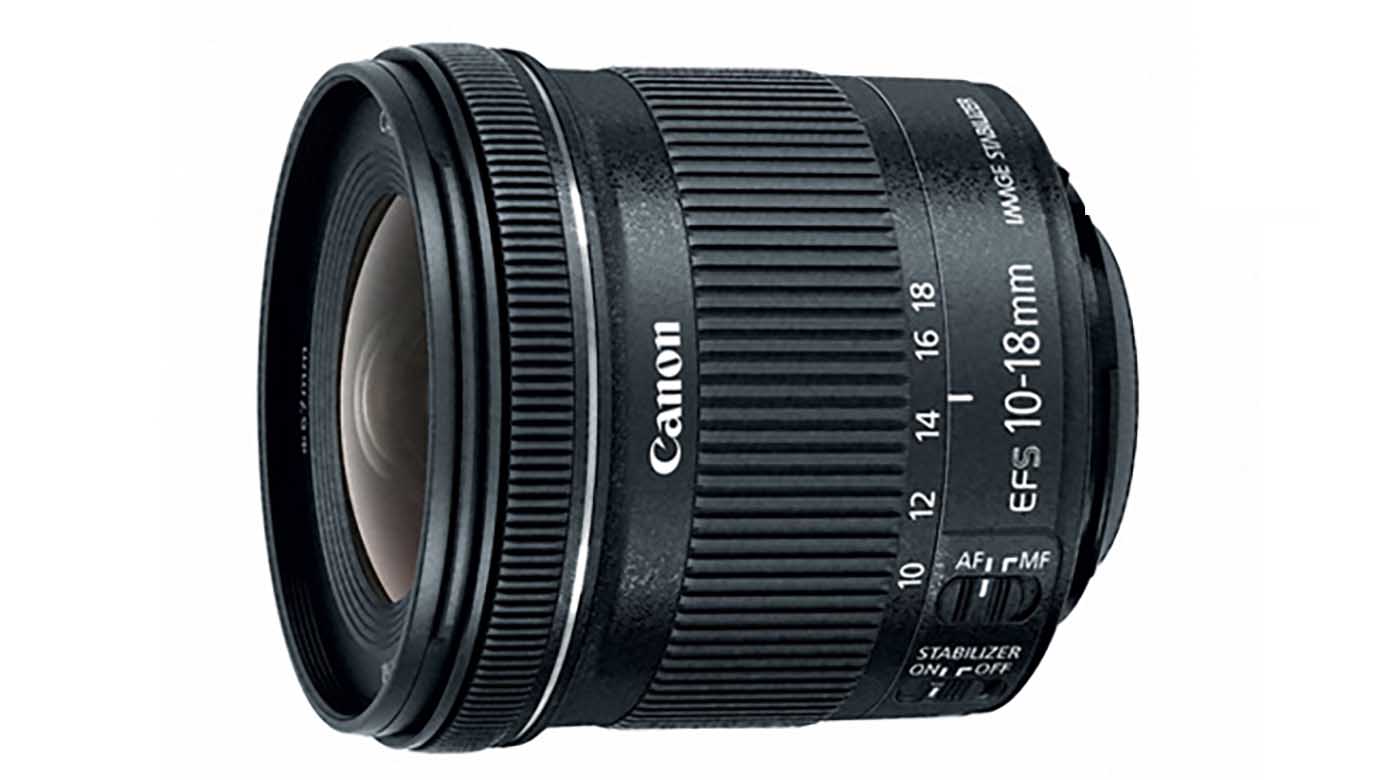
Specification
- Product type: Wide-angle zoom lens
- Announced: May 2014
- Mount: Canon EF-S
- Format: APS-C
- Focal length: 10-18mm, 16-28.8mm
- Maximum aperture: f/4.5-5.6
- Minimum aperture: f/22-29
- Construction: 14 elements in 11 groups
- Focusing system: STM
- Minimum focus distance: 22cm from the focal plane throughout the zoom range
- Maximum reproduction ratio: 0.15x at 18mm
- Stabilisation: Yes to 4 stops
- Number of diaphragm blades: 7
- Filter size: 67mm
- Weight: 240g
- Diameter x length: 74.6 x 72mm
It might be lightweight and very affordable but the Canon EF-S 10-18mm f/4.5-5.6 IS STM is also optical solid, which makes it a great choice of landscape lens for photographers using a Canon APS-C format DSLRs such as the Canon EOS 90D or the Canon Rebel SL3 / 250D.
Its 10-18mm focal length range translates to 16-28.8mm on an EF-S mount camera, which is nice and wide for sweeping vistas. There’s also a closest focusing distance of just 22cm, which means you can go in close to foreground elements and capture high-impact images with plenty of context.
As its barrel and mount are made from plastic and its isn’t weatherproof, the EF-S 10-18mm f/4.5-5.6 IS STM needs to be treated with care and protected from the elements, but at just 240g, it’s a lens you wont mind carrying everywhere.
Helpfully, the lens is also stabilised, which means you won’t need to carry a tripod as often as with a non-stabilised optic.
£195
$299For
- Effective 16-28.8mm focal length range
- Attractively priced
- Lightweight
Against
- Variable maximum aperture
- Lens hood (EW-73C) sold separately
Canon EF 16-35mm f/4L IS USM
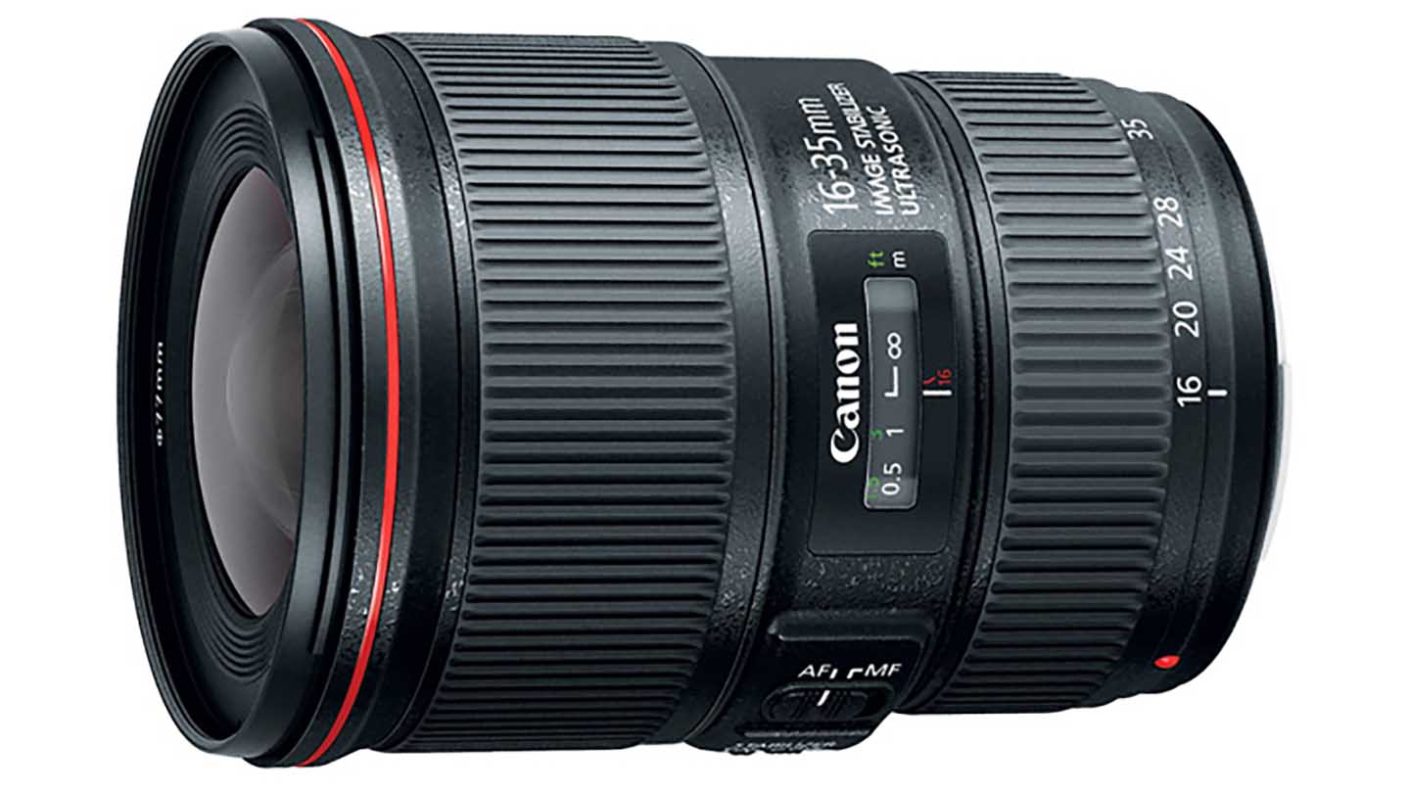
Specification
- Product type: Wide-angle zoom lens
- Announced: May 2014
- Mount: Canon EF
- Format: Full-frame
- Focal length: 16-35mm
- Maximum aperture: f/4
- Minimum aperture: f/22
- Construction: 16 elements in 12 groups with 2 UD (Ultra Low Dispersion) and 3 GMo (Glass-Molded) aspheric elements
- Coatings: Fluorine and Super Spectra Coatings
- Focusing system: Ring USM
- Minimum focus distance: 28cm from the focal plane throughout the zoom range
- Maximum reproduction ratio: 0.23x at 35mm
- Stabilisation: Yes to 4 stops
- Number of diaphragm blades: 9
- Filter size: 77mm
- Weight: 615g
- Diameter x length: 82.6 x 112.8
Although designed for use on Canon full-frame DSLR cameras like the Canon EOS 5D Mark IV, the (comparatively) compact and lightweight EF 16-35mm f/4L IS USM can also be used on APS-C format cameras like Canon EOS 90D, on which it has an effective focal length of 25.6-56mm, which means it makes a good choice of landscape lens for either format.
The Canon EF 16-35mm f/4L IS USM has Canon’s Optical Image Stabilizer (IS) built-in to extend the safe-hand-holdable shutter speed by up to 4EV. That’s useful if you’re not a fan of carrying a tripod.
There’s also an on-board intelligent CPU that enables the lens to understand if it’s being hand-held as normal or if the photographer is panning, and it automatically selects the appropriate IS mode.
The front and rear elements of the lens have fluorine coatings to repel dust and water droplets, while the barrel is weather-sealed – ideal for a landscape lens.
Inner focusing means that the lens doesn’t change length or rotate during focusing so you don’t need to worry about carefully positioned ND grad or polarising filters shifting when you depress the shutter release.
While the sharpness drops off towards the corners of the frame (not an issue with APS-C format cameras), the central area of the lens is very sharp.
£1110
$1099For
- Weather-sealed
- Relatively light and portable
Against
- Sharpness falls off towards the edges
- Maximum aperture of f/4
Canon RF 15-35mm f/2.8L IS USM
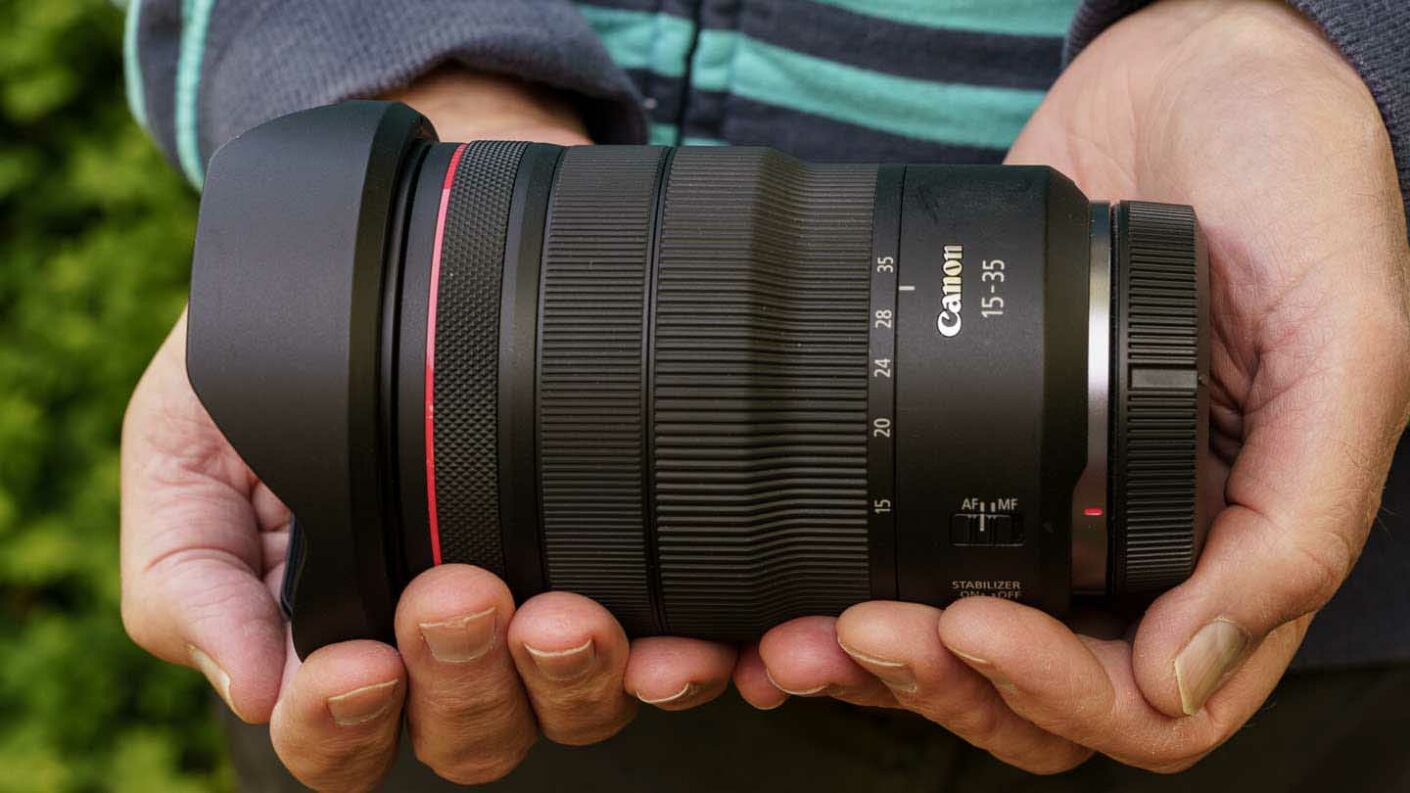
Specification
- Product type: Wide-angle zoom lens
- Announced: August 2019
- Mount: Canon RF
- Format: Full-frame
- Focal length: 15-35mm
- Maximum aperture: f/2.8
- Minimum aperture: f/22
- Construction: 16 elements in 12 groups with 3 aspherical and 2 UD elements
- Coatings: Subwavelength structure coating (SWC), ASC (Air Sphere Coating)
- Focusing system: Nano USM
- Minimum focus distance: 28cm from the focal plane throughout the zoom range
- Maximum reproduction ratio: 0.21x at 35mm
- Stabilisation: Yes to 5 stops
- Number of diaphragm blades: 9
- Filter size: 82mm
- Weight: 840g
- Diameter x length: 88.5 x 126.8
Wide and fast, the Canon RF 15-35mm f/2.8L IS USM is an attractive lens for landscape photographers using a Canon R-series camera such as the Canon EOS R5.
Despite having a slightly wider focal length range, the RF 15-35mm f/2.8L is a fraction smaller than its closest match in the EF mount, the EF 16-35mm f/2.8L III USM. A 1mm difference might not sound much, but it’s significant with very wide lenses.
Combined with the closest focusing of 28cm throughout the zoom range to enable foreground elements to loom large, that extra width could be especially useful for landscape photography. And in low light, the image stabilisation, which extends the safe hand-holdable shutter speed by up to 5EV, could be very handy.
Being a Canon RF lens, the 15-35mm f/2.8L has a customisable lens ring, which is helpful for making intuitive adjustments to aspects such as the aperture or exposure compensation.
You can find the Canon RF 15-35mm f/2.8L IS USM on Amazon UK and Amazon USA
£2389
$2299For
- Excellent optical quality with minimal distortion
- Attractive focal length range
- 5-stop image stabilisation
Against
- High price
- Big and heavy
- No 'de-click' switch for the control ring
Best Fujifilm lenses for landscape photography
Fujifilm X series shooters have a number of small, lightweight options to pick from when choosing the best lens for landscape photography.
Fujifilm Fujinon XF 10-24mm f/4 OIS WR
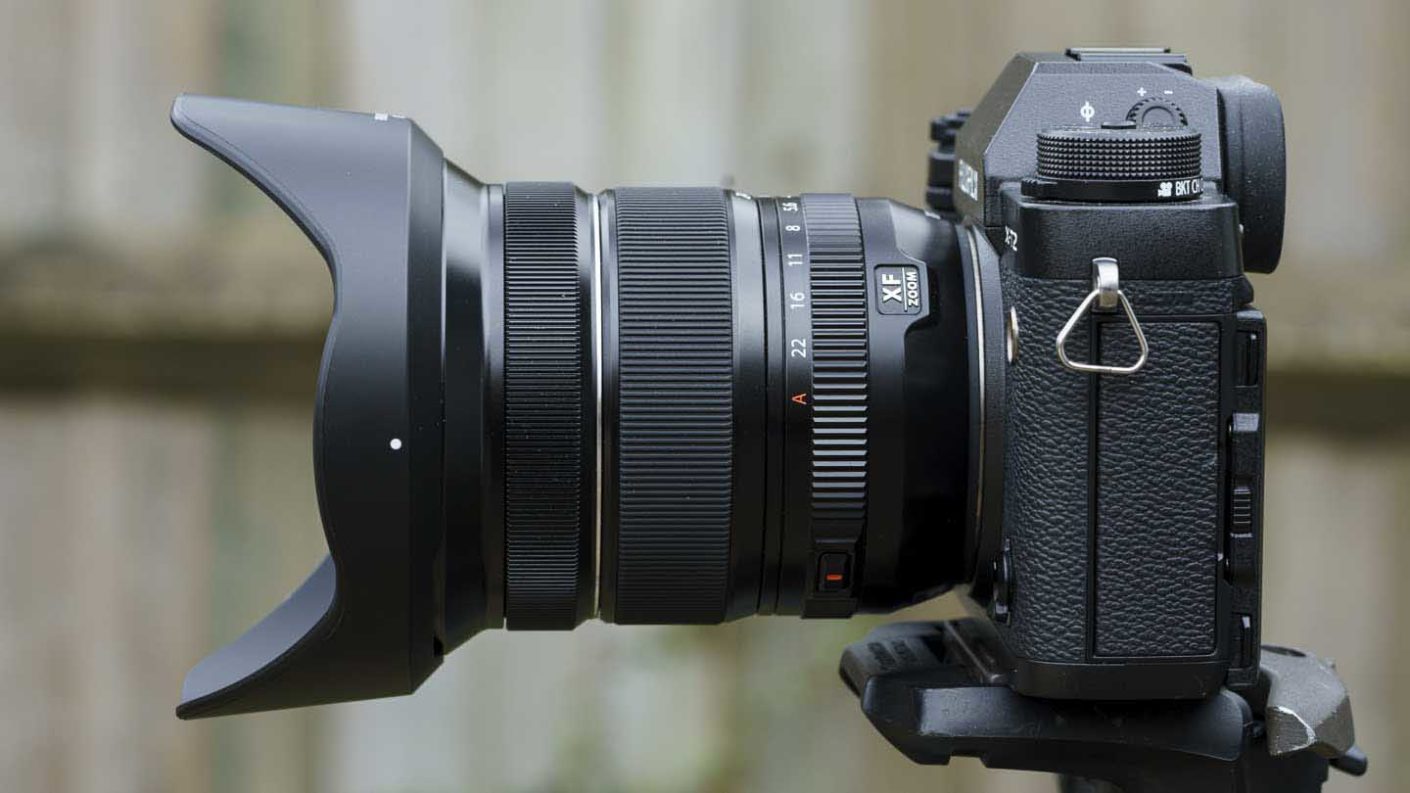
Specification
- Product type: Lens
- Announced: 15th October 2020
- Mount: Fujifilm X
- Focal length: 10-24mm
- Effective focal length: 15-36mm
- Angle of view : 110° - 61.2°
- Maximum aperture: f/4
- Minimum aperture: f/22
- Construction: 14 elements in 10 groups including 4 aspherical elements and 4 extra-low dispersion elements
- Diaphragm blades: 7
- Minimum focus distance (from focal plane): 24cm / 9.5inches
- Maximum magnification: 0.16x at 24mm
- Filter size: 72mm
- Dimensions (diameter x length): 87 x 87mm
- Weight: 385g
The Fujinon XF 10-24mm f/4 R OIS WR has the same optics as the Fujinon XF 10-24mm f/4 R OIS, but it has seals to make it weather-resistant, there’s an enhanced aperture ring with an f-stop scale and an ‘Auto’ setting and the optical image stabilisation (OIS) has been improved boosting the shutter speed compensation from 3.5EV to up to 6.5EV.
Also, despite the additional features, at 385g, the latest XF 10-24mm lens is 25g lighter than its predecessor.
On a Fujifilm X-Series camera like the Fujifilm X-T4, the Fuji XF 10-24mm f/4 R OIS WR has an effective focal length range of 15-36mm, making it ideally suited to landscape photography. At the 10mm end you can stand close to the edge of a river and capture the bank at your feet and the tree branches above your head, while the longer focal lengths allow you to frame the scene a little tighter.
The Fujifilm XF 10-24mm F4 OIS WR is available to order from Amazon UK and Amazon USA
£899
$799For
- Fantastic wide-angle range
- Weather-sealed
- Improved stabilisation
Against
- No distance scale for manual focusing
- Aperture ring not 'declickable'
Fujifilm XF 14mm f2.8 R
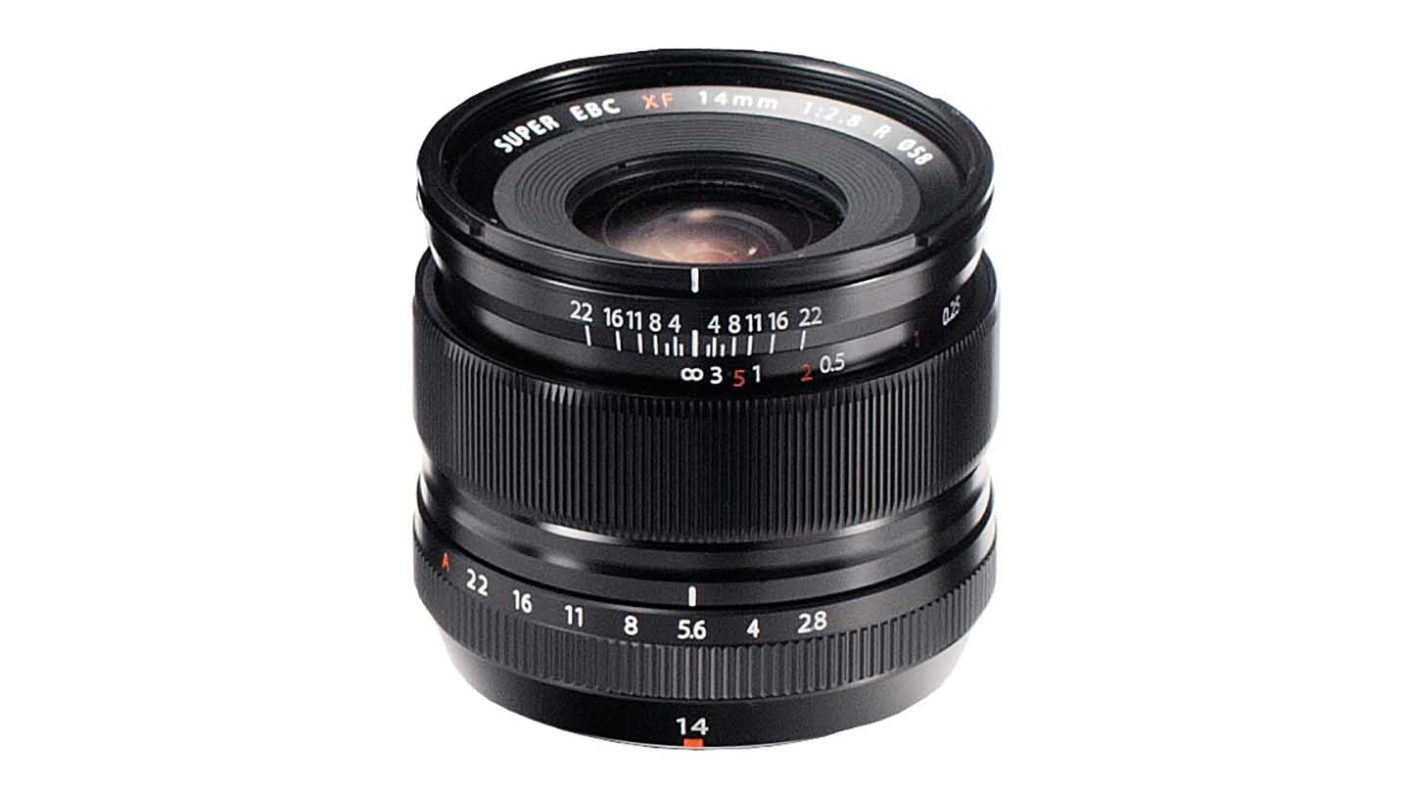
Specification
- Product type: lens
- Announced: March 2013
- Mount: Fujifilm X
- Focal length: 14mm
- Effective focal length: 21mm
- Angle of view: 90.8°
- Maximum aperture: f/2.8
- Minimum aperture: f/22
- Construction: 10 elements in 7 groups with 2 aspherical and 3 extra low dispersion elements
- Diaphragm blades: 7
- Minimum focus distance (from focal plane): 18cm
- Maximum magnification: 0.12x
- Filter size: 58mm
- Dimensions (diameter x length): 65 x 58.4mm
- Weight: 235g
With an effective focal length of 21mm on a Fujifilm X-series camera, the Fujifilm XF 14mm f2.8 R is a compact wide-angle lens that makes a good choice for landscape photography.
While a prime lens lacks the versatility of a zoom lens, the fixed focal length encourages you to explore then scene more rather than zoom in or out to adjust the composition. Also, while perfectly at home on a camera like the Fuji X-T4 or X-T3, Fuji’s prime lenses make a more natural partner for X-E-series cameras like the Fujifilm X-E4 or the X-Pro3.
Thanks to the presence of a focus scale with depth of field markings, which is revealed when the focusing ring is pulled back, the Fujifilm XF 14mm f2.8 R enables hyperfocal distance focusing, which is great news for landscape and street photographers.
£799
$899For
- Compact wide-angle lens
- Focus scale for hyperfocal distance focusing
- Well-built metal barrel
Against
- Not weather-sealed
- Manual and autofocus can't be combined
Best Nikon lenses for landscape photography
Like Canon, Nikon has been building out its mirrorles Nikkor Z series lenses for its mirrorless Z range of cameras, and their image quality is superb. Nikon’s previous AF-S series also offers plenty of choice.
Nikon AF-S DX NIKKOR 10-24mm f/3.5-4.5G ED
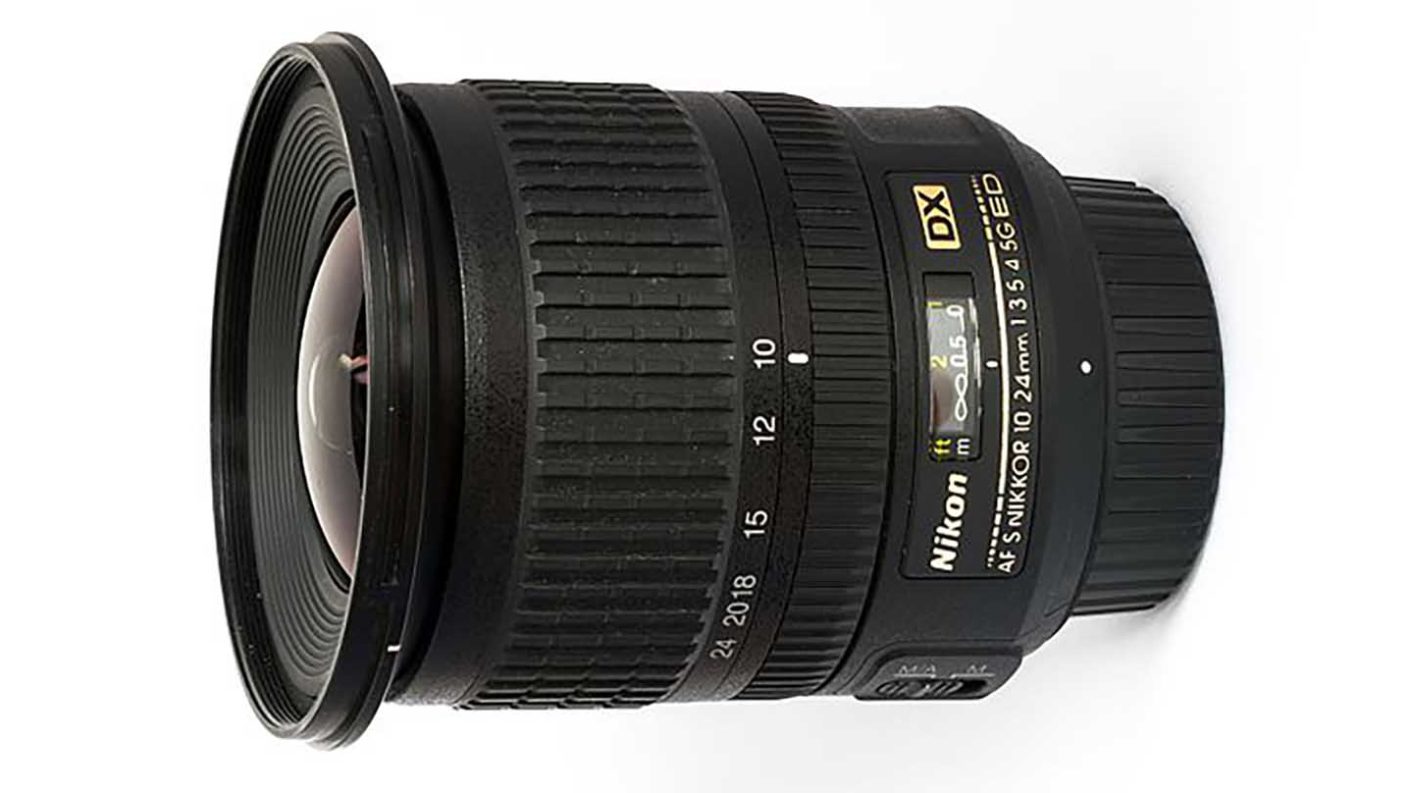
Specification
- Product type: Wide-angle zoom lens
- Announced: 14th Apri 2009
- Mount: Nikon F
- Format: APS-C (DX)
- Focal length: 10-24mm, 15-36mm effective
- Maximum aperture: f/3.5-4.5
- Minimum aperture: f/22-29
- Construction: 14 elements in 9 groups with 2 ED glass and 3 aspherical lens elements
- Focusing system: Internal Silent Wave Motor (SWM)
- Minimum focus distance: 0.24m at all focal lengths
- Maximum reproduction ratio: 0.2x
- Stabilisation: No
- Number of diaphragm blades: 7
- Filter size: 77mm
- Weight: 460g / 16.2oz
- Diameter x length (extension from the lens mount): 82.5 x 87 mm / 3.25 x 3.43ichesn
More expensive than the Nikon AF-P DX Nikkor 10-20mm f/4.5-5.6G VR and lacking the VR image stabilisation system, the AF-S DX NIKKOR 10-24mm f/3.5-4.5G ED is a better optical performer with excellent centre sharpness and little vignetting.
Like the AF-P DX Nikkor 10-20mm f/4.5-5.6G VR, this lens is designed for use on Nikon APS-C (DX) format DSLRs on which its effective focal length is 15-36mm. That’s a great range for landscape photography and the closest focusing distance of 24cm enables high-impact foreground interest.
Nikon’s Silent Wave Motor (SWM) focusing system is fast and accurate, but more significantly for landscape photographers, it operates internally so that the front element doesn’t rotate so there are no problems when using polariser or graduated filters.
Further good news is that, while the lens isn’t fully weather-sealed, the mount is metal and there’s a rubber gasket to exclude dust and moisture.
£699
$896.95For
- Small and lightweight
- Excellent centre sharpness
- Vignetting is controlled very well for such a wide lens
Against
- No VR built-in
- Not weather-sealed
Nikon Nikkor AF-S 16-35mm f/4G ED VR

Specification
- Product type: Wide-angle zoom lens
- Announced: February 2010
- Mount: Nikon F
- Format: Full-frame (FX)
- Focal length: 16-35mm
- Maximum aperture: f/4
- Minimum aperture: f/22
- Construction: 17 elements in 12 groups with 2 ED glass and 3 aspherical lens elements
- Coatings: Nano Crystal Coat
- Focusing system: Silent Wave Motor (SWM)
- Minimum focus distance: 0.29m at a focal length of 16mm or 35mm, 0.28m at a focal length between 20mm and 28mm
- Maximum reproduction ratio: 0.25x
- Stabilisation: Yes
- Number of diaphragm blades: 9
- Filter size: 77mm
- Weight: 680g / 24.0oz
- Diameter x length (extension from the lens mount): 82.5 x 125mm
When it was introduced in February 2010, the Nikon AF-S 16-35mm f/4G ED VR was the first ultra-wide zoom lens to feature image stabilisation or vibration reduction (VR) as Nikon calls it. Highly effective, the VR extends the safe hand-holdable shutter speed by up to 4EV, which is useful for landscape photographers who don’t like carrying a tripod.
Featuring the Nikon F mount, the lens is designed for use on Nikon DSLRs. While its image circle covers a full-frame (FX) sensor, on APS-C (DX) format cameras it offers an effective focal length of 24-52.5mm, making it a useful landscape lens for either camera type.
Nikon’s optical design ensures that chromatic aberrations are controlled very well and the lens produces superb results, especially when closed down to around f/8 or f/11. However, there’s significant barrel distortion visible at the 16mm end which could be an issue when shooting cityscapes or architectural photography.
£1169
$1096.95For
- High quality results
- Attractive focal length for full-frame (FX) and APS-C (DX) format
- Excellent build quality with weather-sealing
Against
- Significant barrel distortion at the 16mm end
- Big lens for the aperture
Nikon Nikkor Z 14-24mm f/2.8 S

Specification
- Product type: Wide-angle zoom lens
- Mount: Nikon Z
- Format: Full-frame (FX)
- Focal length: 14-24mm
- Maximum aperture: f/2.8
- Minimum aperture: f/22
- Construction: 16 elements in 11 groups including 4 ED elements and 3 aspherical elements
- Coatings: Nano Crystal and ARNEO coatingss, and a fluorine-coated front element
- Focusing system: Internal autofocusing
- Minimum focus distance: 28cm from the focal plane throughout the zoom range
- Maximum reproduction ratio: 0.13x at 24mm
- Stabilisation: No
- Number of diaphragm blades: 9
- Filter size: 112mm or rear gels
- Weight: 650g / 1lb 7oz
- Diameter x length (extension from lens mount): 88.5 x 124.5mm /3.5 x 5-inches
Built and priced with professional photographers in mind, the Nikon Z 14-24mm f/2.8 S is a faster and more expensive alternative to the Nikkor Z 14-30mm f/4 S. Along with the usual zoom and manual focus rings, the Z 14-24mm f/2.8 S has a dedicated control ring, a customisable function button and a small display screen that can reveal key information such as the aperture setting, focus distance or the exact focal length.
Designed for Nikon’s mirrorless Z-series camera which has in-body image stabilisation, the Nikkor Z 14-30mm f/4 S doesn’t have Vibration Reduction (VR) built-in.
Unusually, the lens comes with two lens hoods, one for normal use and the other for use with 112mm screw-in filters. Alternatively, the Z 14-24mm f/2.8 S can accept gel filters in its rear slot, but it’s not directly compatible with filter holders.
Measuring 88.5 x 124.5mm / 3.5 x 5-inches and weighing 650g / 1lb 7oz, the Nikon Z 14-24mm f/2.8 S is significantly smaller and lighter than the Nikon AF-S Nikkor 14-24mm f/2.8G ED (98 x 131.5mm / 3.9 x 5.2-inches and 1000g /35.3oz), which is for Nikon DSLR cameras. That means it’s easier to carry and use for long periods of time. Also, the front element is far less bulbous and therefore less prone to attracting water droplets.
One of the reasons that Nikon introduced the Z mount was to enable faster and better-quality optics to be created and the Nikkor Z 14-24mm f/2.8 S demonstrated this by delivering superb images throughout its zoom and aperture ranges. There’s even a good level of detail in the corners of images shot at the wodest point with the widest aperture.
£2499
$2397For
- Superb image quality even at maximum aperture
- Fast and quiet AF
- Significantly lighter and smaller than F-mount equivalent
Against
- This type of lens doesn't come cheap
- Two lens hoods required (supplied), one for with 112mm filters and one without
- Can't be used with filter holders - ruling out graduated filters
Nikon Nikkor Z 14-30mm f/4 S

Specification
- Product type: Wide-angle zoom lens
- Announced: 8th January 2019
- Mount: Nikon Z
- Format: Full-frame (FX)
- Focal length: 14-30mm
- Maximum aperture: f/4
- Minimum aperture: f/22
- Construction: 14 elements in 12 groups with 4 ED elements and 4 aspherical elements
- Coatings: Nano Crystal and a fluorine-coated front element
- Focusing system: Internal autofocusing
- Minimum focus distance: 28cm from the focal plane throughout the zoom range
- Stabilisation: No
- Number of diaphragm blades: 7
- Filter size: 82mm
- Weight: 485 g / 1 lb 1.2 oz
- Max diameter x length (extension from lens mount whee the lens is retracted)): 89 x 85mm
Although the Nikon Z 14-30mm f/4 S is a stop slower than the Nikon Z 14-24mm f/2.8 S, it’s also much smaller, has 6mm longer reach and is more affordable, which makes it a very attractive alternative for photographers shooting with a Nikon Z-series mirrorless camera.
It also has the benefit of an 82mm filter mount and, as it can be used with filter holders, it’s compatible with graduated filters. That’s good news for landscape photographers, especially those wanting to shoot long exposures during the day.
Despite its second-fiddle billing behind the 14-24mm f/2.8, the Nikon Z 14-30mm f/4 S is sealed against dust and moisture. In addition, the front element is fluorine-coated to make it easier to keep clean. All adding to the lens’s appeal to landscape photographers.
If you’ve used the AF-S Nikkor 14-24mm f/2.8G ED on a DSLR, the Nikon Z 14-30mm f/4 S seems like a baby of a lens in comparison. However, it has a greater zoom range and it’s easier to use with filters. Its collapsible design also makes it a little more portable than it might otherwise be.
Also, while the lens is designed to cover a full-frame sensor, it has an effective focal length range of 21-45mm on the APS-C format Nikon Z50.
You can find the Nikon Nikkor Z 14-30mm f/4 S at Amazon UK and Amazon US.
£1349
$1296.95For
- Excellent sharpness up to f/16
- Distortion is controlled very well
- Significantly more affordable than the 14-24mm f/2.8
Against
- Collapsing mechanism lacks the high-quality feel of the rest of the lens
- F/4 rather than f/2.8
- No dedicated control ring
Nikon Nikkor Z 20mm f/1.8 S
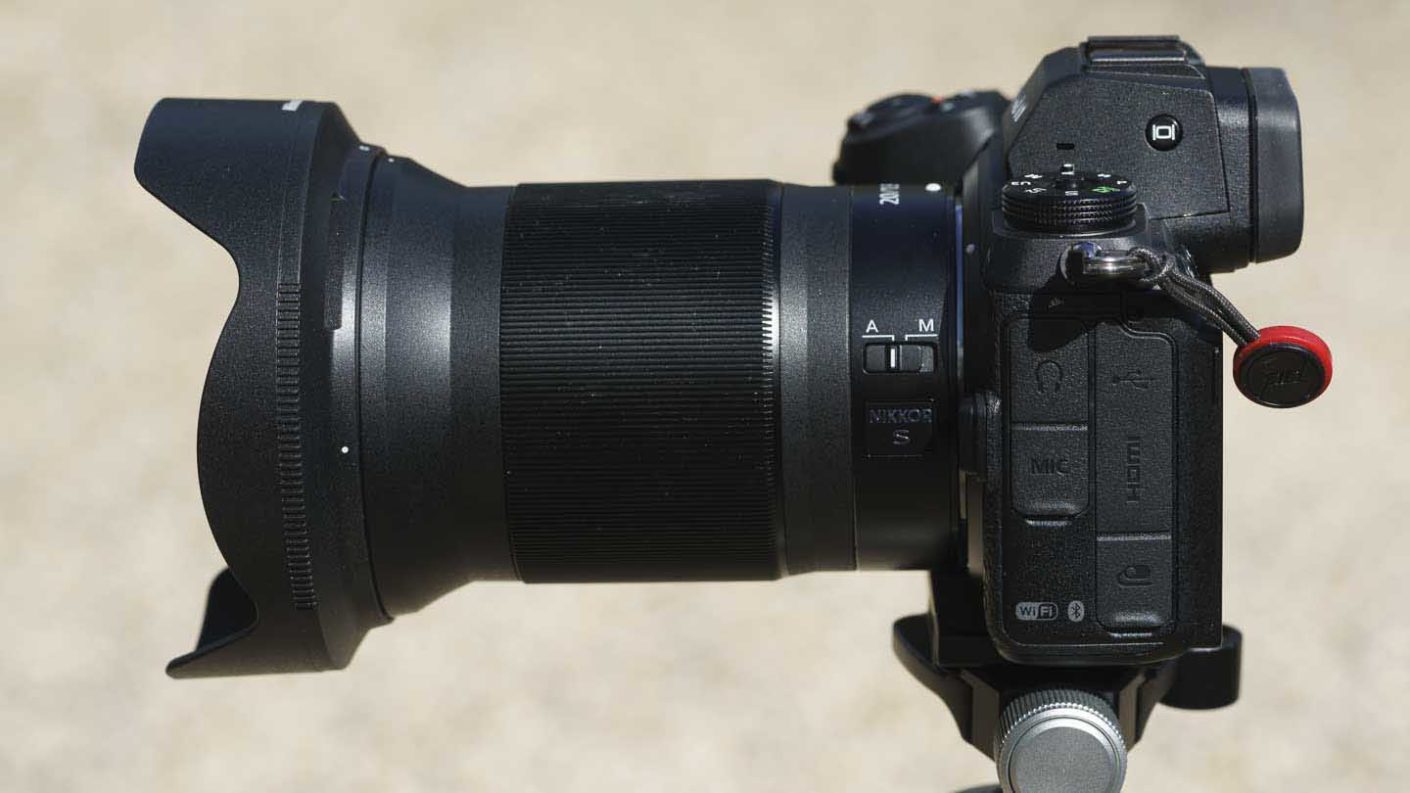
Specification
- Product type: Wide-angle prime lens
- Announced: 12th February 2020
- Mount: Nikon Z
- Format: Full-frame (FX)
- Focal length: 20mm
- Maximum aperture: f/1.8
- Minimum aperture: f/16
- Construction: 14 elements in 11 groups (including 3 ED elements, 3 aspherical elements, and elements with Nano Crystal Coat)
- Coatings: Nano Crystal Coat
- Focusing system: Internal autofocusing
- Minimum focus distance: 0.2m
- Maximum reproduction ratio: 0.19x
- Stabilisation: Yes
- Number of diaphragm blades: 9
- Filter size: 77mm
- Weight: 505g
- Diameter x length (extension from lens mount): 84.5 x 108.5mm
The NIKKOR Z 20mm f/1.8 S is the latest optic in Nikon’s S-line of bright f/1.8 lenses. It features a 9-blade aperture for smooth background blur, and a minimum focus distance of 0.2m.
As well as ED glass, it also is coated with Nikon’s anti-reflective Nano Crystal Coat to prevent ghosting and flare.
This Nikon Z full-frame lens offers fast, smooth AF performance, which makes it perfect for video, and it’s weather-sealing means you can shoot in any conditions.
On the lens barrel are focus rings and a control ring that can be customised for ISO, silent aperture control or exposure compensation.
You can find the Nikkor Z 20mm f/1.8 S at Amazon UK and Amazon US.
£999
$1046For
- Fast aperture
- Weatherproof
- Excellent sharpness
Against
- Big for the focal length
- No focus distance scale
Best Olympus lenses for landscape photography
In the time since we first wrote this guide, Olympus has become OM System, and has now begun launching new lenses and cameras under the new brand. Whatever you may call them, Olympus / OM System makes some of the best glass you can buy, with plenty of options for landscape photography.
Olympus M. Zuiko 7-14mm f/2.8 ED PRO
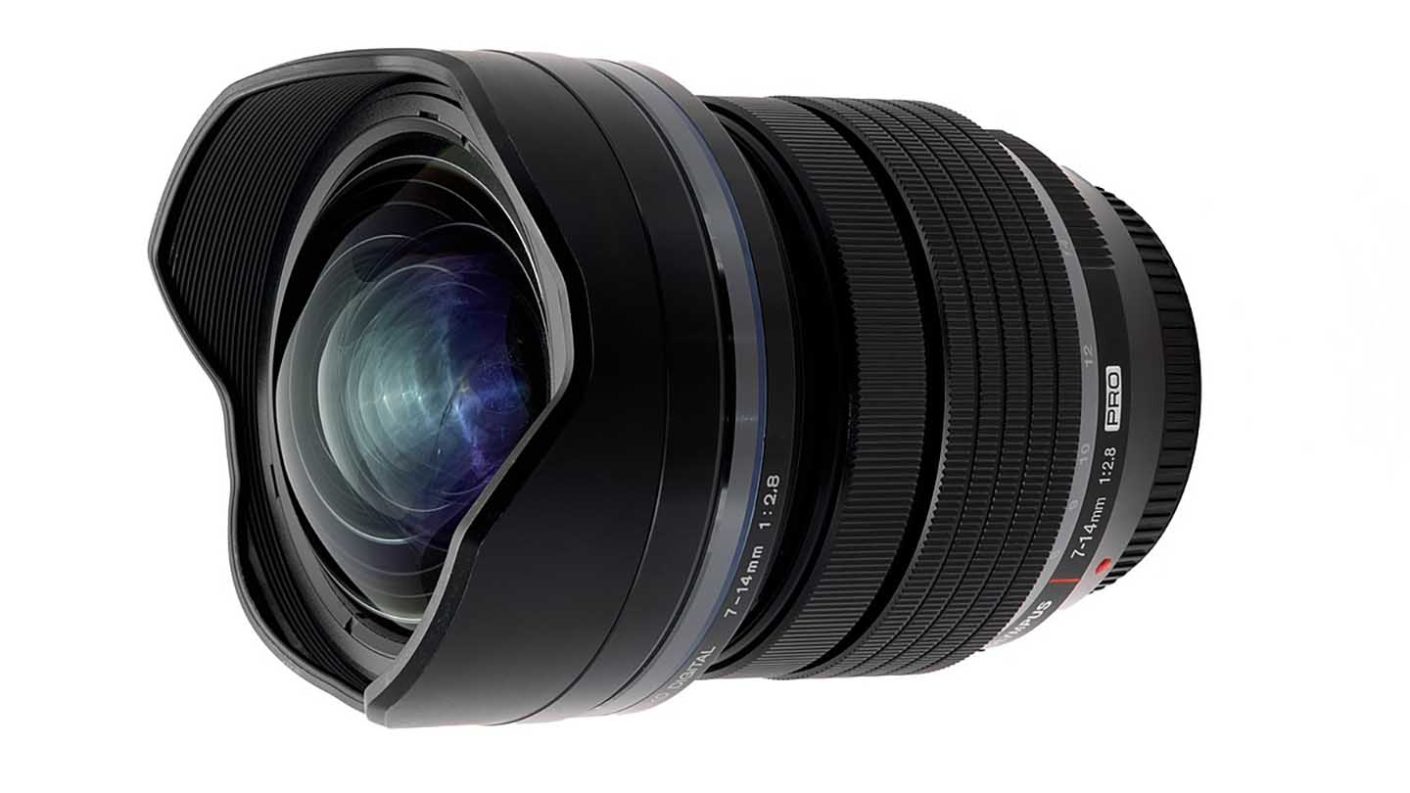
Specification
- Product type: Wide zoom lens
- Announced: May 2015
- Mount: Micro Four Thirds
- Focal length: 7-14mm, effective 14-28mm
- Angle of view: 114-75°
- Closest focusing distance: 0.2m
- Maximum magnification: 0.12x Micro Four Thirds) / 0.24x 35mm format
- Construction: 14 elements in 11 groups with 1 DSA, 3 aspherical ED, 1 ED, 3 Super ED and 2 HR elements
- Maximum aperture range: f/2.8
- Minimum aperture: f/22
- Image stabilisation: No
- Filter diameter: -
- Dimensions (length x diameter): 105.8 x 78.9mm
- Weight: 534g
Designed for Micro Four Thirds cameras, the Olympus M. Zuiko 7-14mm f/2.8 ED PRO has an effective focal length range of 14-28mm, which is great for landscape photography. Matched by the Panasonic Lumix G Vario 7-14mm f/4 Asph., it’s the widest optic available for the system.
The M. Zuiko 7-14mm f/2.8 ED PRO is also built to a high standard with weather-sealing and superb optics that enable it to deliver excellent-quality results throughout its focal length and aperture range.
Unfortunately, like many ultra-wide lenses the M. Zuiko 7-14mm f/2.8 ED PRO doesn’t have a filter thread, but there are adapters available to enable filters to be used.
Building a high quality constant f/2.8 lens isn’t cheap so the Oympus M. Zuiko 7-14mm f/2.8 ED PRO costs a fair whack but it compares well with similar optics. It’s also comparatively heavy and is, therefore, better suited to larger Micro Four Thirds cameras like the Olympus OM-D E-M1 Mark III, OM-D E-M1X or the Panasonic Lumix G9. If you use a smaller camera like the Olympus OM-D E-M5 Mark III or Olympus OM-D E-M10 Mark IV, the Panasonic Lumix G Vario 7-14mm f/4 Asph. may be a better choice.
However, if you opt for the Oympus M. Zuiko 7-14mm f/2.8 ED PRO, it’s unlikely that you will be disappointed.
£1059
$1399For
- Excellent optical performance
- Solid construction and weatherproof build
- Constant f/2.8 aperture
Against
- Relatively big and heavy
- Needs an adapter to accept filters
- More expensive than the Panasonic Lumix G Vario 7-14mm f/4 Asph.
Olympus M. Zuiko 12-40mm f/2.8 PRO
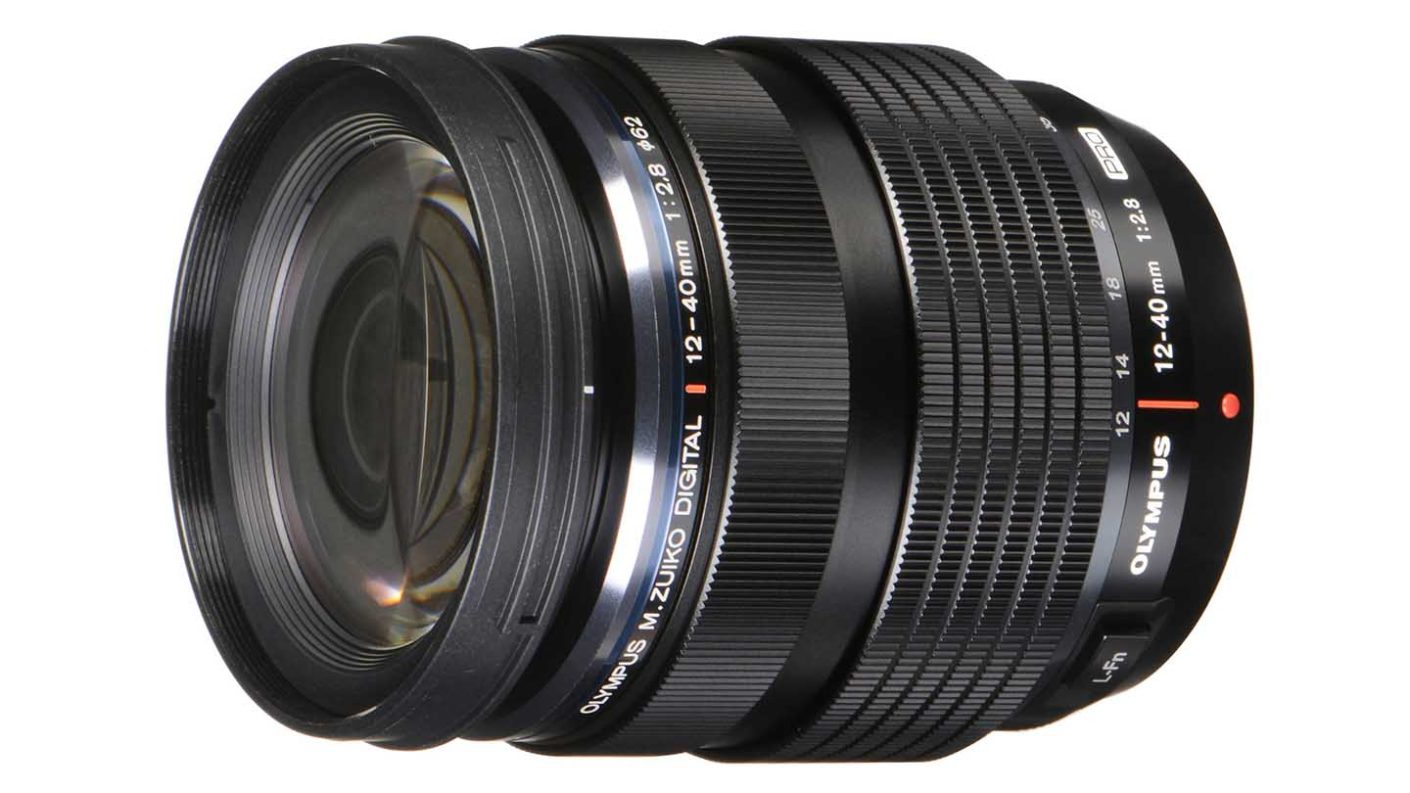
Specification
- Product type: Wide/standard zoom lens
- Announced: September 2013
- Mount: Micro Four Thirds
- Focal length: 12-40mm, effective 24-80mm
- Angle of view: 84-30°
- Closest focusing distance: 0.2m
- Maximum magnification: 0.3x Micro Four Thirds / 0.6x 35mm format
- Construction: 14 elements in 9 groups with 2 High-refractive, 2 Aspherical ED, 2 DSA and 2 ED elements
- Number of aperture blades: 7
- Maximum aperture range: f/2.8
- Minimum aperture: f/22
- Image stabilisation: No
- Filter diameter: 62mm
- Dimensions (length x diameter): 84 x 69.9mm
- Weight: 382g
Designed for professional use, the Olympus M. Zuiko 12-40mm f/2.8 PRO is built to a high standard and has wetherproof seals.
The M. Zuiko 12-40mm f/2.8 PRO is designed for use on Micro Four Thirds mirrorless cameras like the Olympus OM-D E-M1 Mark III, OM-D E-M1X, Olympus OM-D E-M5 Mark III and Panasonic Lumix G9 on which it’s subject to a 2x focal length magnification factor. That means it’s effectively a 24-80mm lens, which makes it a great everyday workhorse optic as well as a good choice for landscape photography.
With a filter thread of 62mm, the M. Zuiko 12-40mm f/2.8 PRO doesn’t demand big, expensive filters and it can be used with a wide range of filter holders.
It’s also a high-quality optic that delivers superb results with plenty of detail across the whole frame and little distortion.
buy the Olympus M. Zuiko 12-40mm f/2.8 Pro from Amazon UK or Wex Photo Video in the UK and Adorama or B&H Photo Video in the USA.
£900
$999For
- Excellent optical performance
- Compact size, solid construction and weatherproof build
- Constant f/2.8 aperture
Best Panasonic lenses for landscape photography
Like its partner in developing the Micro Four Thirds system, Panasonic has a number of great lens options for landscape photographers.
Panasonic Lumix G Vario 7-14mm f/4
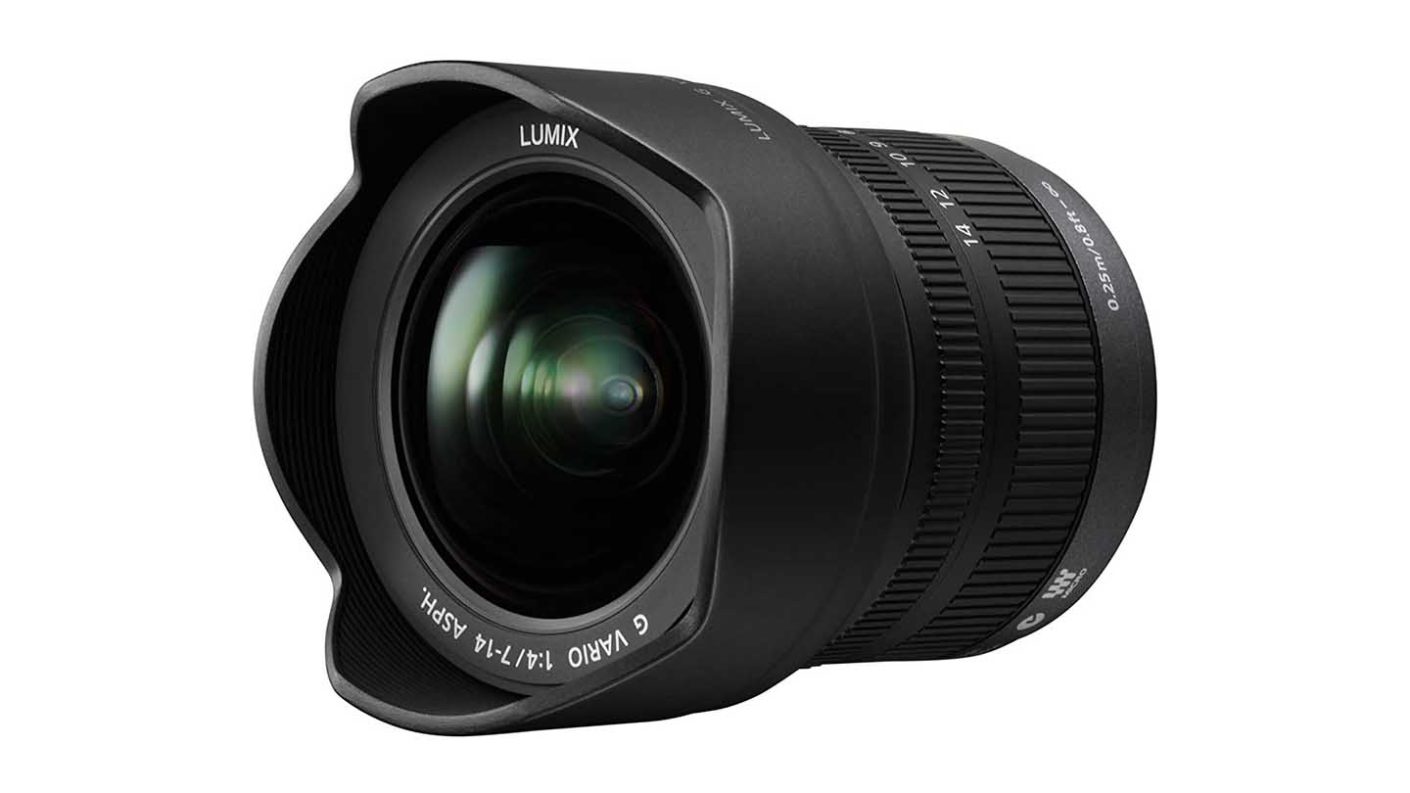
Specification
- Product type: Wide-angle lens
- Announced: March 2009
- Mount: Micro Four Thirds
- Format: Four Thirds
- Focal length: 7-14mm
- Maximum aperture: f/4
- Minimum aperture: f/22
- Construction: 16 elements in 12groups (2 Aspherical lenses, 4 ED lenses)
- Coatings: Nano AR Coating
- Focusing system: Automatic only
- Minimum focus distance: 0.25m
- Maximum reproduction ratio: 0.08x
- Stabilisation: Via camera body
- Number of diaphragm blades: 7
- Filter size: No filter thread
- Weight: 300g
- Diameter x length: 70mm x 83mm
Designed for capturing big, sweeping vistas, Panasonic’s Lumix G Vario 7-14mm f/4 offers an equivalent focal length of 14-28mm with a 114-degree angle of view. Despite its 2x wide-angle zoom range, the 7-14mm f/4 is surprisingly compact and lightweight and weighs next to nothing in your camera bag.
Its seven-blade aperture produces nice shallow depth of field effects, while multiple coatings on the lens’ front element help reduce ghosting and flare.
The Lumix G Vario 7-14mm f/4 isn’t cheap, but you’re getting what you pay for in edge-to-edge sharpness and very little vignetting, plus its compact size.
If you’re looking for a lens that boasts all these qualities and will challenge you to look at the landscape from new perspectives, this could be the best lens for you.
Get the Panasonic Lumix G Vario 7-14mm f/4 at Amazon UK or Amazon US.
£800
$797For
- Compact, lightweight design
- Super wide-angle zoom range
- Constant f/4 aperture
Against
- No image stabilisation
- Expensive
Panasonic Leica DG Vario-Elmarit 8-18mm f/2.8-4 Asph.
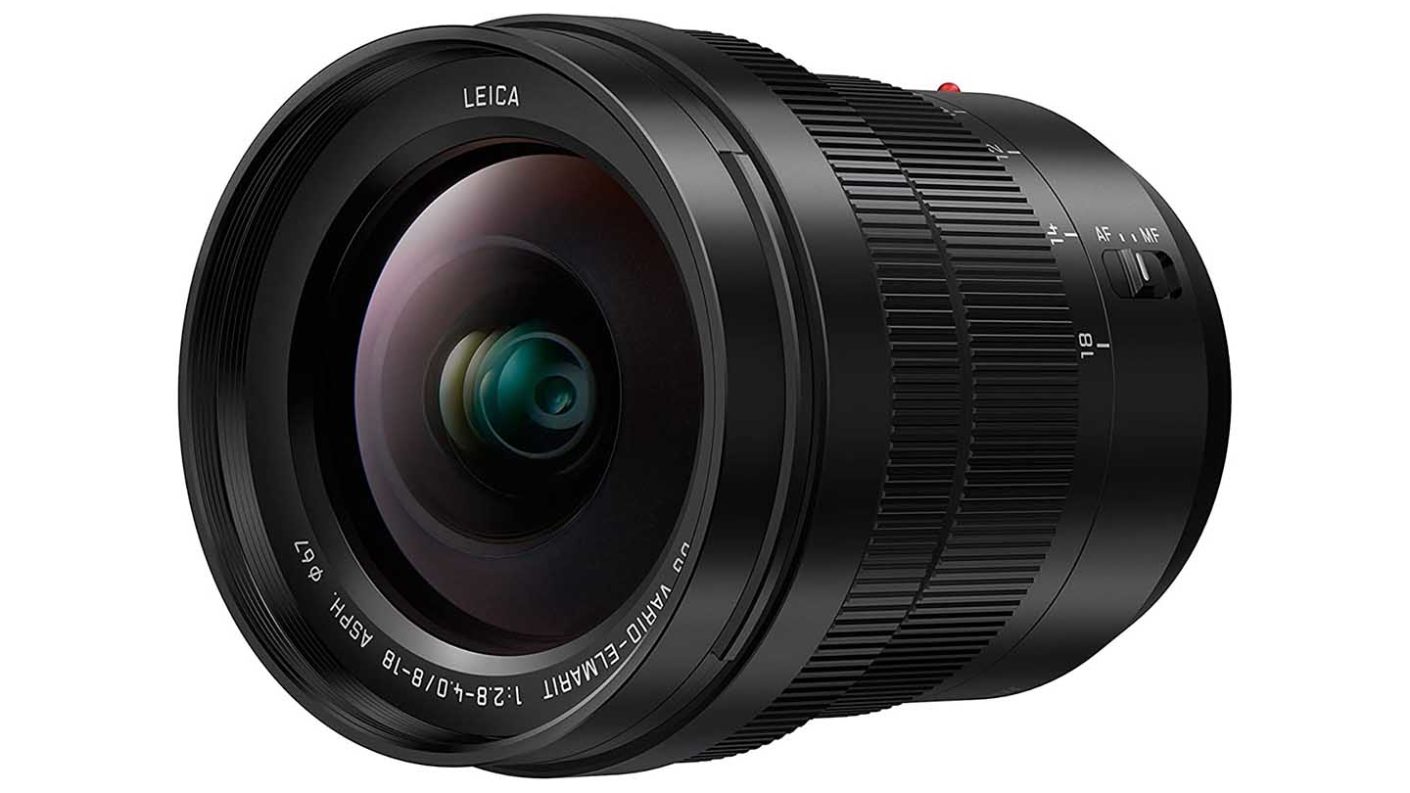
Specification
- Product type: Wide-angle zoom lens
- Announced: April 2017
- Mount: Micro Four Thirds
- Format: Four Thirds
- Focal length: 8-18mm
- Maximum aperture: f/2.8 (Wide) - f/4.0 (Tele)
- Minimum aperture: f/22
- Construction: 15 elements in 10 groups (1 aspherical ED lens, 3 aspherical lenses, 2 ED lenses, 1 UHR lens)
- Coatings: Nano Surface Coating
- Minimum focus distance: 0.23m / 0.75ft
- Maximum reproduction ratio: Approx. 0.12x / 0.24x
- Stabilisation: Via camera body
- Number of diaphragm blades: 7
- Filter size: 67mm
- Weight: 315g
- Diameter x length: 73mm x 83mm
A robust all-rounder, the Panasonic Leica DG Vario-Elmarit 8-18mm f/2.8-4 Asph offers an equivalent focal length of 16-36mm and can be used in poor weather conditions, thanks to its weather-sealing and metal body.
Developed as part of Panasonic’s partnership with Leica, the 8-18mm f/2.8-4 provides excellent contrast and colours, and sharpness is consistent throughout the frame.
The lens gives you a 16mm equivalent wide angle focal length, which is very wide, and image quality is very sharp at this end. Other features include support for AF and a focusing ring for manual focus.
Get the Panasonic Leica DG Vario-Elmarit 8-18mm f/2.8-4 Asph. at Amazon UK or Amazon US.
£870
$1097For
- Weather-sealed
- Constant f/4 aperture
Against
- No image stabilisation
- Expensive
Panasonic Lumix S Pro 16-35mm f/4
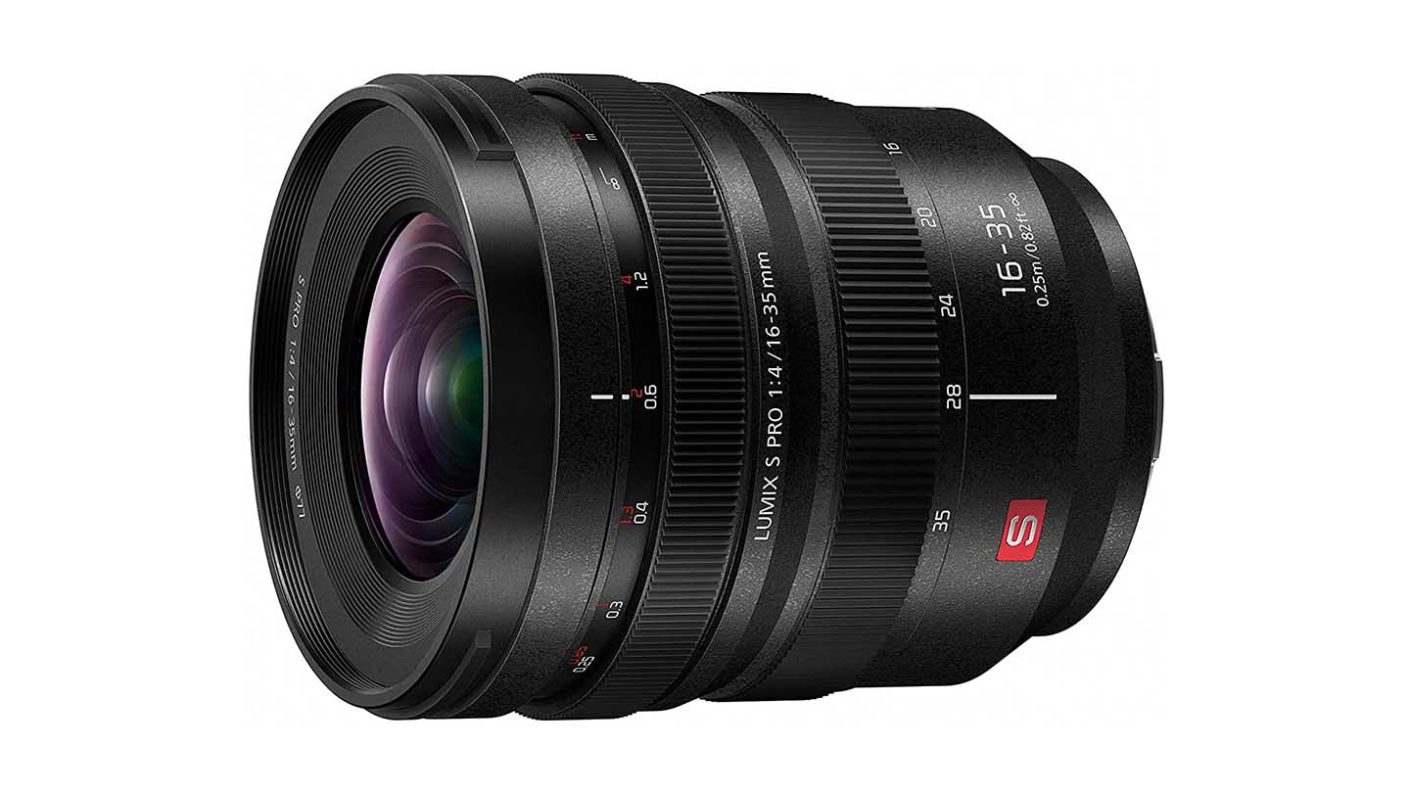
Specification
- Product type: Wide-angle zoom lens
- Announced: November 2019
- Mount: Micro Four Thirds
- Format: Four Thirds
- Focal length: 8-18mm
- Maximum aperture: f/2.8 (Wide) - f/4.0 (Tele)
- Minimum aperture: f/22
- Construction: 12 elements in 9 groups (3 aspherical lenses, 1 ED lens, 1 UHR lens)
- Coatings: Nano Surface Coating
- Minimum focus distance: 0.23m / 0.75ft
- Maximum reproduction ratio: Approx. 0.12x / 0.24x
- Stabilisation: Via camera body
- Number of diaphragm blades: 9
- Filter size: 77mm
- Weight: 500g
- Diameter x length: 85mm x 99.6mm
The LUMIX S Pro 16-35mm F4 is a compact wide-angle zoom that weighs just 500g and offers a robust build quality that is dust and splash proof. Inside, it has a nine-blade aperture that produces stunning bokeh effects, something you don’t often see in a wide-angle lens.
You can focus as close as just 25cm, and its 77mm filter thread means you can mount a variety of filters for all sorts of creative effects.
Colours are strong, subjects are well defined, and images are sharp across the frame. AF performance is also fast and price, and Panasonic has included a focus clutch mechanism for instantly switching between AF and MF.
Get the Panasonic Lumix S Pro 16-35mm f/4 at Amazon UK or Amazon US.
£1499
$1497For
- Fast, quiet autofocus
- Beautiful bokeh
Against
- Expensive
Best Sigma lenses for landscape photography
With a focus on high-end performance, you can make the case that Sigma produces the best lenses for landscape photography that money can buy. And you will part with that money. But if you’ve invested in a high-end camera and image quality is important to you, shouldn’t you also invest in high-end lenses?
Sigma 14-24mm f2.8 DG DN Art
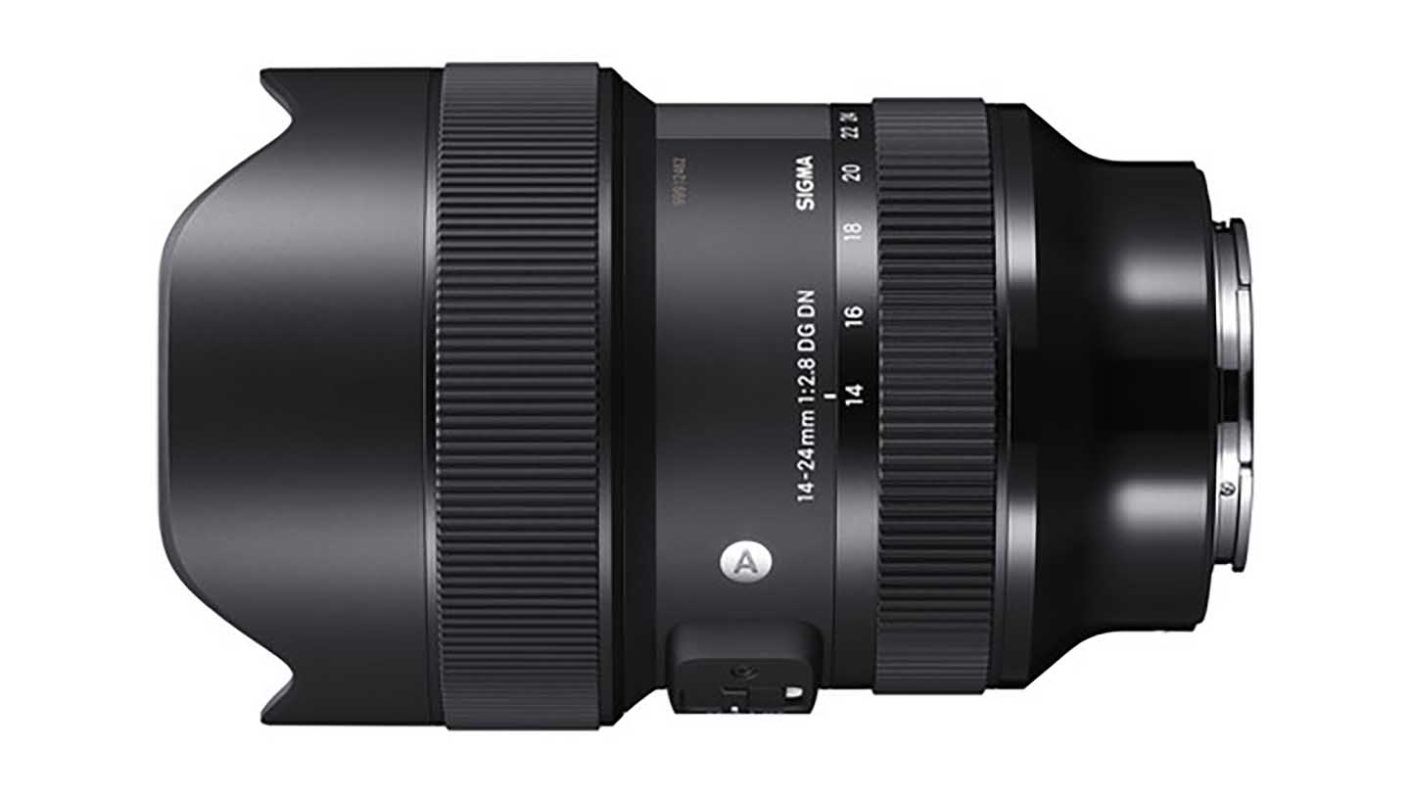
Specification
- Product type: Wide-angle zoom lens
- Announced: July 2019
- Mount: L or Sony FE
- Format: Full-frame
- Focal length: 14-24mm
- Maximum aperture: f/2.8
- Minimum aperture: f/22
- Construction: 18 elements in 13 groups with 1 FLD, 5SLD and 3 aspherical elements
- Coatings: Super multi-layer and NPC (Nano Porous Coating)
- Focusing system: Stepping motor autofocusing with internal focusing
- Minimum focus distance: 28cm from the focal plane throughout the zoom range
- Maximum reproduction ratio: x0.137
- Stabilisation: No
- Number of diaphragm blades: 11
- Filter size: Rear filter holder
- Weight: 795g / 28oz
- Diameter x length (extension from lens mount): 85 x 131mm / 3.3 x 5.2-inches
Sigma is part of the L-Mount Alliance which means that as well as other mount lenses, it can produce optics for L-mount cameras like the Panasonic Lumix S5, S1 and S1R. Currently, the Sigma 14-24mm f2.8 DG DN Art is available in the L mount and Sony FE mount.
As part of Sigma’s Art lens range, the 14-24mm f2.8 DG DN Art is a high-quality optic with a delightful build and weather-sealing. There’s some barrel distortion visible when shooting at the shorter end of the zoom-range but in other respects, this lens produces superb results.
While the focal length range is very attractive for high-impact landscape photography, the ultra-wide design means that the Sigma 14-24mm f2.8 DG DN Art isn’t directly compatible with most filter holders and there’s a gel-filter slot at the mount-end. With the appropriate adapter in place, the lens can be used with the Lee Filters SW150 Mark II system, but even then you can expect to see significant vignetting at the shortest end and it’s best to stick to 15mm or longer.
£1299
$1399For
- Huge viewing angle
- Excellent optical performance
- Attractively priced
Against
- Only available in FE and L mount
- Not directly compatible with filter holders
Best Sony lenses for landscape photography
After some early complaints about the pace of its lens development, Sony’s E mount range of lenses is filling out nicely, with a number of great options for landscape photographers at a variety of price points.
Sony E 10-18mm f/4 OSS
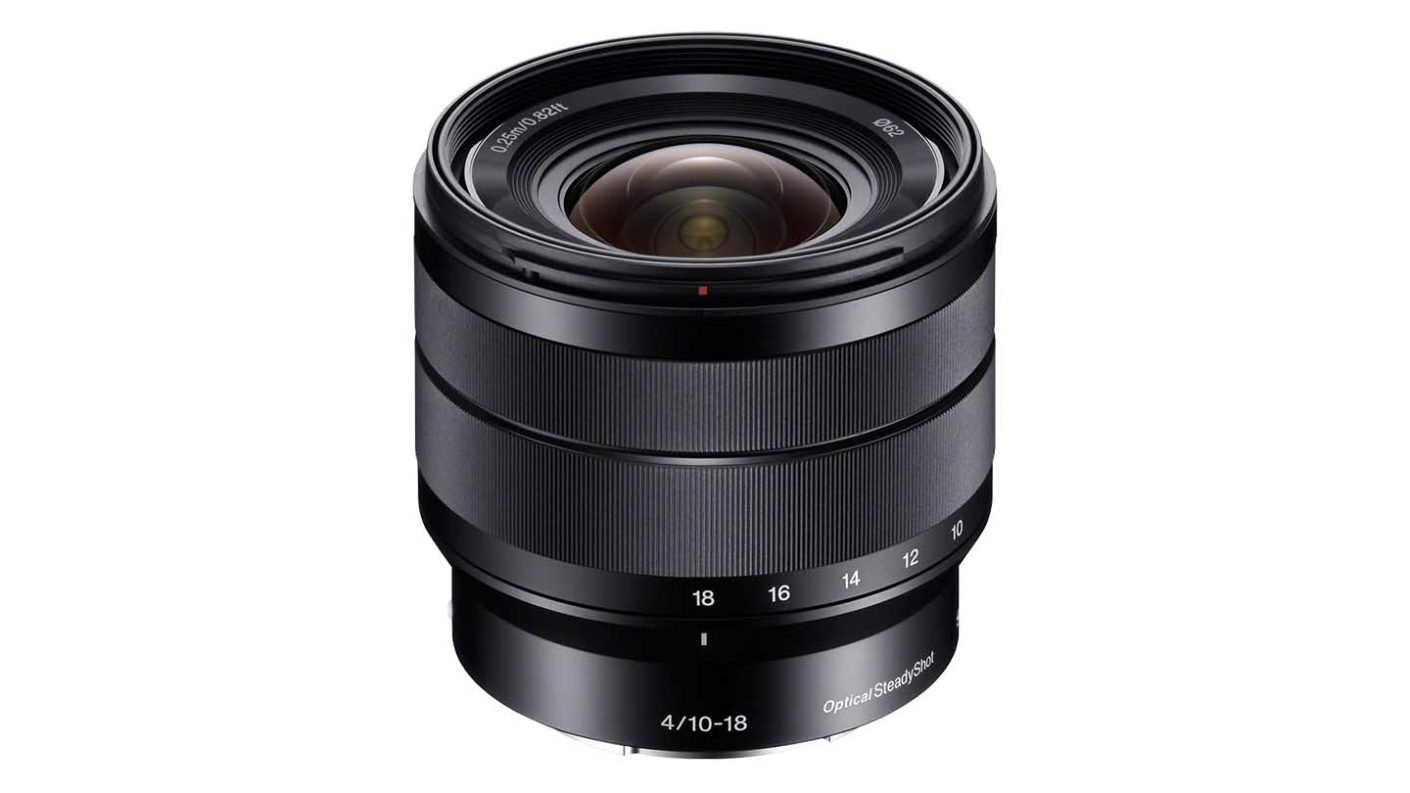
Specification
- Product type: Wide-angle zoom lens
- Announced: September 2012
- Mount: Sony E
- Format: APS-C
- Focal length: 10-18mm
- Maximum aperture: f/4
- Minimum aperture: f/22
- Construction: 8 elements in 10 groups
- Coatings: Nano Surface Coating
- Minimum focus distance: 0.25m
- Maximum reproduction ratio: 0.1x
- Stabilisation: Optical SteadyShot
- Number of diaphragm blades: 7
- Filter size: 62mm
- Weight: 225g
- Diameter x length: 70.0 x 63.5mm
Designed for Sony’s APS-C series mirrorless cameras, the E 10-18mm f/4 OSS is a lightweight wide-angle zoom that offers a constant maximum aperture of f/4 through the entire focal range.
The lens also offers built-in Optical SteadyShot image stabilisation that provides up to 4-stops of stabilisation, which makes it ideal for shooting low-light landscapes and night photography. Its weather sealing against dust and moisture also make it ideal for using in all conditions.
The lens is sharp across the frame, and colours are striking with plenty of contrast.
£589
$849.99For
- Built-in image stabilisation
- Very lightweight
Against
- Some drop-off in sharpness at the edges
Sony FE 16-35mm f/2.8 GM

Specification
- Product type: Wide-angle zoom lens
- Announced: May 2017
- Mount: Sony FE
- Format: 35mm full frame
- Focal length: 16-35mm
- Maximum aperture: f/2.8
- Minimum aperture: f/22
- Construction: 8 elements in 10 groups with two Sony XA (extreme aspherical) elements
- Coatings: Fluorine-coated front element, Nano AR Coating
- Minimum focus distance: 0.28m
- Maximum reproduction ratio: 0.19x
- Stabilisation: Body integrated
- Number of diaphragm blades: 11
- Filter size: 82mm
- Weight: 680g
- Diameter x length: 88.5 x 121.6mm
Designed for Sony’s full-frame mirrorless cameras, the FE 16-35mm f/2.8 GM is a top-notch lens that’s designed to get the most out of a high-resolution full-frame sensor such as the one found in the Sony A7 R IV.
It’s not cheap, and it relies purely on the camera’s stabilisation system, but the quality of the results that it produces is impressive, making the FE 16-35mm f/2.8 GM very desirable for landscape photography.
Further good news is that’s extensively sealed against dust and moisture and it can accept 82mm screw-in filters and filter holders.
Get the Sony FE 16-35mm f/2.8 GM at Amazon UK
£2300
$2200For
- Accepts front-mounted filters
- Great performance
- Dust and moisture resistant
Against
- High price
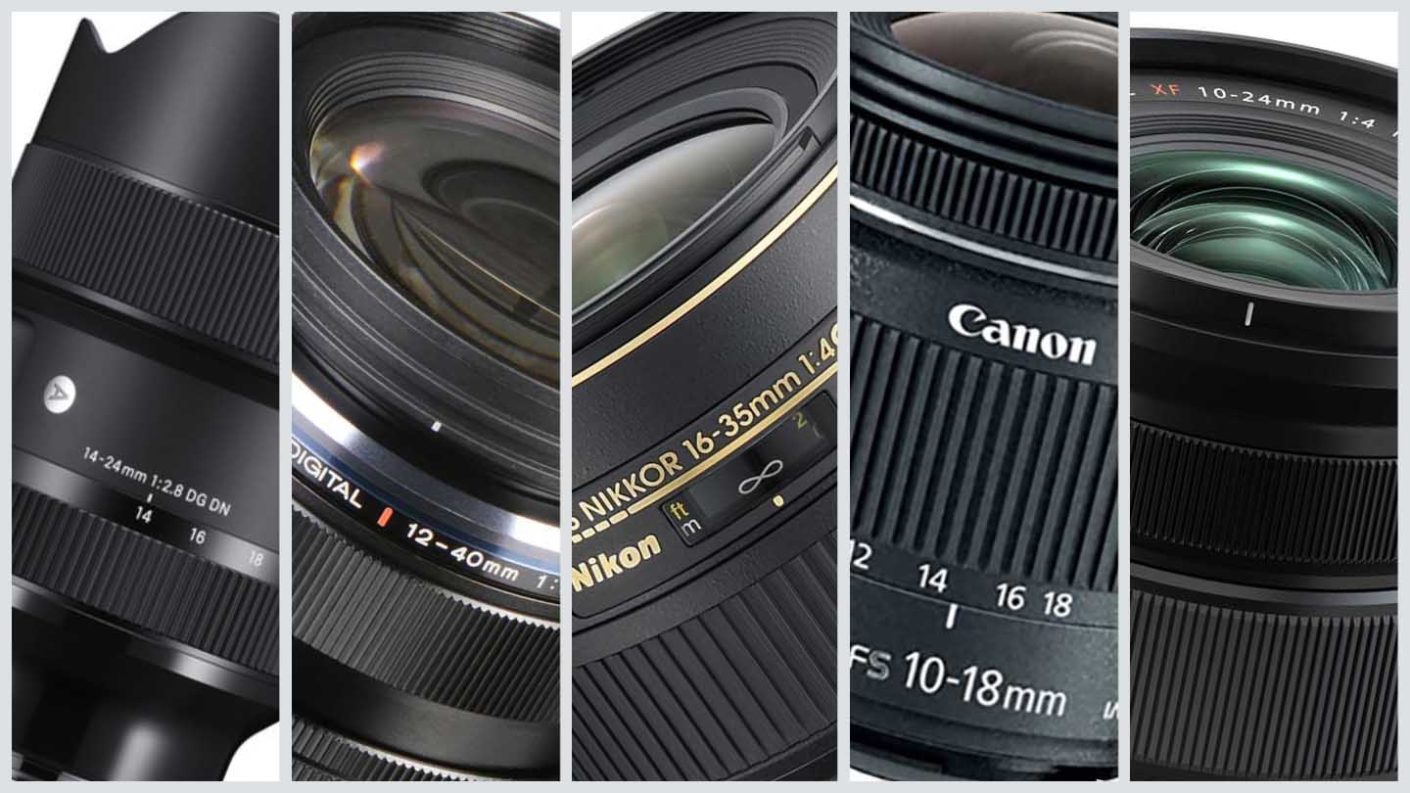



Exclusive Canon lenses: good.
Exclusive Nikon lenses: good.
Exclusive Sony lenses: good.
Sigma lens for L and FE: AGAINST – > Only available in FE and L mount.
Great.